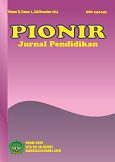THE EFFECT OF THE PICTURE AND PICTURE LEARNING MODEL ON THE SHORT STORY WRITING SKILLS OF GRADE IV STUDENTS OF SD NEGERI SUKAHARJA 1, TANGERANG REGENCY
DOI:
https://doi.org/10.22373/pjp.v13i3.25209Keywords:
pendidikanAbstract
This research aims to find out whether there are differences in short story writing skills between students who were given the picture and picture learning model and students who were given the conventional learning model in class IV students at SDN Sukaharja 1, Tangerang Regency. This research uses a quasi-experimental research method with a non-equivalent control group design. The population subjects in this study were class IV students at SDN Sukaharja 1 Tangerang Regency, taking a sample of two classes totaling 54 students, namely class IV A totaling 27 students as the experimental class and class IV B totaling 27 students as the control class. Data collection techniques using short story writing skills test instruments, observation, interviews and documentation. To test the pretest hypothesis in this study using the t test, from the t test results obtained tcount = 1.8658 and ttable = 2.0066, this difference of 0.1408 shows that the tcount value is slightly lower than ttable, it can be concluded that there is no difference in results between the experimental class and the control class. Meanwhile, for testing the posttest hypothesis, the results of the t test obtained tcount = 11.3936 and ttable = 2.0066, so it can be concluded that the picture and picture learning model has an influence on the short story writing skills of class IV students at SDN Sukaharja 1, Tangerang Regency.
Keywords: Picture and Picture Learning Model, Short Story Writing Skills
References
A. Octavia, S. (2020). Model-Model Pembelajaran. Deepublish.
Athaini, F. (2021). Peningkatan kemampuan menulis cerita dengan menggunakan metode picture and picture pada siswa kelas IV SDN 02 Kalirejo. Action Reseacrh Journal.
Banyu Biru, R., Muharam, A., & Fajrussalam, H. (2021). Pengaruh Metode Picture and Picture dalam Meningkatkan Keterampilan Menulis Cerita Siswa Sekolah Dasar. Renjana Pendidikan 1.
Djaali. (2022). Metodologi Penelitian Kuantitatif (B. Sari Fatmawati, Ed.; 2nd ed.). PT. Bumi Aksara.
Faridah, S., Ulfah, M., & Ramadhani, M. I. (2022). Pelatihan Menulis Cerpen sebagai Penguatan Program Literasi Siswa. 3, 169–173.
Fitriawati Musyafa, N. (2020). Penggunaan Model Picture and Picture dalam Pembelajaran Menulis Cerpen. Alinea: Jurnal Bahasa, Sastra, Dan Pengajaran, 9(1), 37. https://doi.org/10.35194/alinea.v9i1.626
Musaba, Z., & Siddik, M. (2018). Dasar-Dasar Keterampilan Menulis (A. Istiadi, Ed.; 2nd ed.). Aswaja Pressindo.
Praseptia, D., & Zulherman, Z. (2021). Pengaruh Model Pembelajaran Picture and Picture Terhadap Peningkatan Prestasi Belajar Siswa Sekolah Dasar. Edukatif : Jurnal Ilmu Pendidikan, 3(5), 3018–3025. https://doi.org/10.31004/edukatif.v3i5.1073
Rohman, S. (2023). Pembelajaran Cerpen (2nd ed.). PT. Bumi Aksara.
Samino, F. A. (2018). Hubungan Berpikir Kreatif Dan Kemampuan Membaca Pemahaman Dengan Kemampuan Menulis Cerpen Siswa Kelas V Sekolah Dasar Strada Bhakti Nusa. JPD:Jurnal Pendidikan Dasar.
Tegor. (2020). Metodologi Penelitian Kualitatif & KUANTITATIF . Penerbit Lakeisha.
Tri Hatmo, K. (2021). Keterampilan Menulis Bahasa Indonesia (S. Wibawa, Ed.). Penerbut Lakeisha.
Downloads
Published
Issue
Section
License
- Authors retain copyright and grant the journal right of first publication with the work simultaneously licensed under a Creative Commons Attribution License that allows others to share the work with an acknowledgment of the work's authorship and initial publication in this journal.
- Authors are able to enter into separate, additional contractual arrangements for the non-exclusive distribution of the journal's published version of the work (e.g., post it to an institutional repository or publish it in a book), with an acknowledgment of its initial publication in this journal.
- Authors are permitted and encouraged to post their work online (e.g., in institutional repositories or on their website) prior to and during the submission process, as it can lead to productive exchanges, as well as earlier and greater citation of published work (See The Effect of Open Access).

